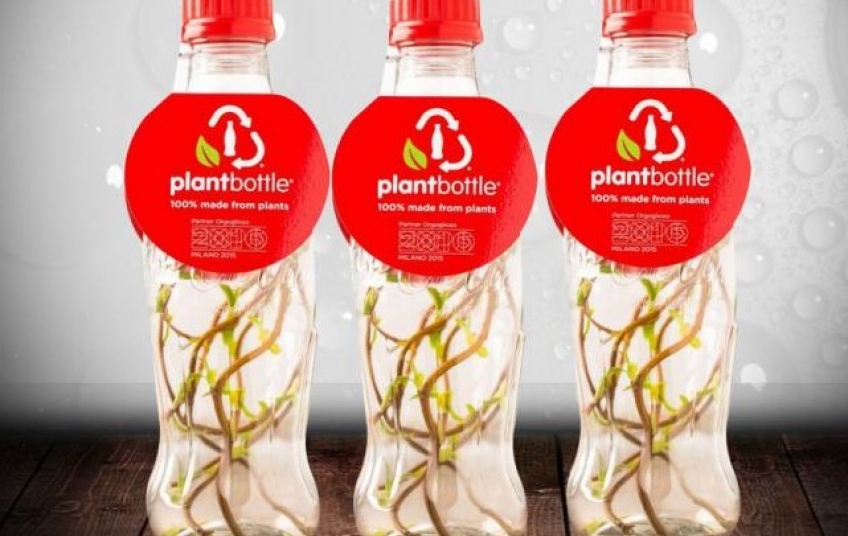Every day people are coming up with new ideas on how to better package products. First, it was being able to recycle the package materials, and now people are continually coming up with newer and better biodegradable and environmentally friendly materials. Companies have already begun the transition into better materials.
Tetra Pak was the first to make a 100% plant-based packaging material milk carton. The carton’s mainframe is made out of bio-based low-density polyethylene film and the cap is made out of bio-based high-density polyethylene. The material fits in with their old system of how they make cartons, so they do not have to invest extra money into redesigning the cartons.
However, Coca-Cola has now taken Tetra Pak’s idea one step further and made a 100% plant-based polyethylene terephthalate (PET) plastic bottle. Coca-Cola’s vision is: “to maximize game-changing technology, using responsibly sourced plant-based materials to create the globe’s first fully recyclable PET plastic bottle made entirely from renewable materials.” They have technology that is able to produce PET plastics from natural sugars that are in plants. With our natural resources starting to become scarce, they have developed a way to produce plastic bottles that are renewable and do not harm the planet in any way.
Along with The Coca-Cola Company, many other companies are trying to stop using fossil fuels and nonrenewable resources, and begin using more bio-based materials.
A website, GreenHome, highlights some plastic and paper products made from raw materials such as: bamboo, wood, recycled paper, bioplastics, and bagasse. The bamboo they use is a renewable resource that is compostable and biodegradable. They have different woods used for different packaging. For instance, they use cellophane for bags and sheets because it can block out or keep in air, grease, and bacteria really well and can be sealed by heat. Their bioplastics (plant starch) are made from things found in plants like hemp oil, soy bean oil, and corn starch. Bagasse (sugar cane) has the least effect on the environment. Because it is strong and does not deform easily, they are able to use it to make take-away boxes, plates, bowls, and ice cream cups. It is very heat and water resistant and will not suffocate the food. GreenHome is doing a great job with coming up with new ways to help better the people and the earth.
Even if companies are not able to get completely 100% plant-based materials, it is better to have a little than none at all. Clear Lam Packaging has developed a bag that is ninety percent plant-based renewable raw materials. They were able to come up with a way to replace petroleum-based plastics with renewable Ingeo PLA (polylactic acid). They even discovered a way to make the plant-based bags act and feel like the old bags.
There will come a time when everyone will stop hurting the planet we live on by drilling holes for oil, producing a lot of greenhouse emissions, and using up our non-renewable resources, and start becoming sustainable. Even with something that may seem as simple as packaging products, we can help the Earth. Using plant-based packaging materials is not only helpful to the planet, but to the people on it as well.
References
Hower, Mike. “Tetra Pak Launches First Package Made From 100% Plant-Based Packaging Materials”. Sustainable Brands: The Bridge to Better Brands. Sustainable Life Media Inc. 16 Oct. 2014. Web. 20 Nov. 2015.
http://www.sustainablebrands.com/news_and_views/packaging/mike_hower/tetra_pak_launches_first_package_made_100_plant-based_packaging_
Sustainable Brands. “Coke Unveils World's First Entirely Plant-Based PET Bottle”. Sustainable Brands: The Bridge to Better Brands. Sustainable Life Media Inc. 3 June 2015. Web. 20 Nov. 2015.
http://www.sustainablebrands.com/news_and_views/packaging/sustainable_brands/coke_unveils_worlds_first_entirely_plant-based_pet_bottl
Green Home. GreenHome. n.p., n.d. Web. 20 Nov. 2015.
http://www.greenhome.co.za/raw-materials/
Renewable Plant-Based Packaging Uses Raw Materials・. Food Processing: The Information Source for Food and Beverage Manufacturers. Food Processing. n.d. Web. 20 Nov. 2015.
http://www.foodprocessing.com/vendors/products/2010/120/
Image Source: http://www.ateriet.com/wp-content/uploads/2015/06/plantbottle.jpg


































